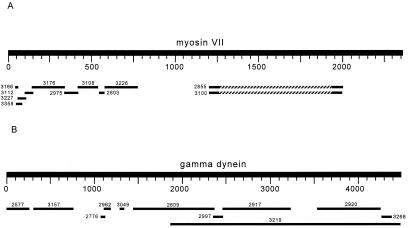Figure 2.
(A) tblastn search of D. discoideum myosin VII (AAF06035) against armU. As was the case for kl-5, this search yielded a staggered pattern. PCR with primers designed from several of these fragments showed that they are not male-specific, and are thus not Y-linked. This finding implies that autosomal heterochromatic genes also show a staggered pattern in such a blast search. Hatched segments represent intervening regions of no alignment. The amino acid sequence of this putative gene is different from the previously identified myosin VII homolog crinkled (AAF44915). (B) A tblastn search with the C. reinhardtii γ-dynein (Q39575) against the armU database reveals a large number of fragments, many of which were shown by PCR to be male-specific. From this pattern, scaffold-specific PCRs were done on DNA from Y deficiency males to associate genomic fragments with fertility factor regions. RT-PCR was then done to fill the sequence gaps.

